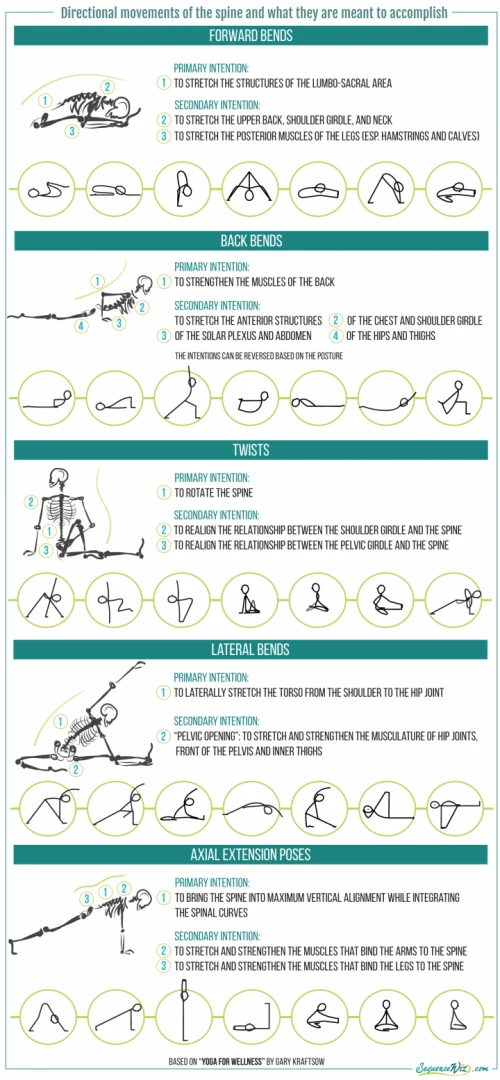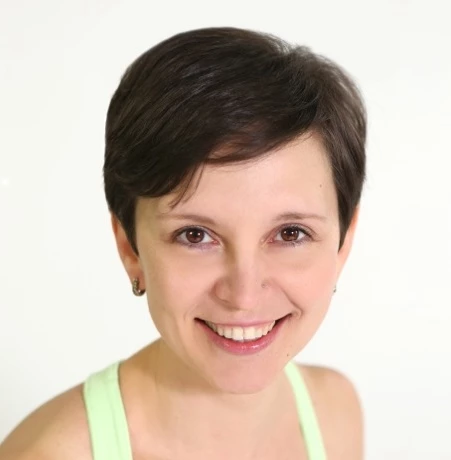Why Do We Practice Particular Poses? The 5 Spinal Movements and Their Benefits

I remember reading an article couple of years ago by a yoga teacher who observed that there’s a tendency for many teachers to give too much anatomical instruction in yoga classes. As expected, she got a lot of heat from other teachers who passionately commented that detailed anatomical instruction is absolutely necessary to avoid injury and to get the student deeper into the pose, among other things.
Personally, I would frame the problem a bit differently. I believe that there is often not enough “why” in yoga classes. The lack of attention to the “why” of practice is being compensated for and overshadowed by “how.” The consequence of this approach is that many students have memorized where each body part should go in each individual pose (including where the thumb is pointing), but have very little understanding of why we do the pose in the first place. The result is that we have a great fascination with forms of poses at the expense of function.
Making Spinal Position a Priority
In my tradition, it is always the opposite. We start by understanding what the pose is meant to accomplish, and then based on that, guide the student into the form of the posture. Whatever we do in yoga we need to do for a reason. Otherwise, why bother? That is why when we describe a pose, we always start by identifying the position of the spine, since the position of the spine gives us immediate clues about what the pose is meant to accomplish.
I am sensing that there is still some confusion among yoga teachers as to why we need this sort of classification. For example, one point I hear often is that there is no such thing as a pure lateral bend; there is always an element of rotation in it. Okay, sure, but we are missing the point here. This type of classification is important for understanding the function of individual poses; it is not about the purity of the spinal position itself.
Utthita Trikonasana (Extended Triangle Pose) is classified as a lateral bend because it shares the same intentions with all other lateral bends (to stretch and strengthen the lateral structures of the torso, to facilitate deeper breathing by working the intercostal muscles and expanding the ribcage, and so on). Does it have a bit of a spinal rotation in it? Sure. Yet when we perform the pose we focus on the lateral bending and try to minimize the rotation to protect the lower back and sacrum.
Janu Sirsasana (Head-of-the-Knee Pose) has an element of lateral bending, but it is mostly a forward bend. Adho Mukha Svanasana (Downward-Facing Dog Pose) has an element of forward bending, but it is mostly an axial extension posture, and so on. Knowing where the pose belongs classification-wise helps us understand both why we do it and how to teach it.
Here is a summary of the five directional movements of the spine and what they are meant to accomplish.

Learn more from YogaUOnline and Olga Kabel – Common Alignment Mistakes in Forward Bends and Twists.
Would you like more practice tips and inspiration from Olga Kabel? Read 7 Ways to Troubleshoot Balance Poses.
Study core strength and so much more with Olga Kabel and YogaUOnline – Yoga for Posture Improvement with Focus on Core Strengthening and Axial Extension.
Reprinted with permission from Sequence Wiz.
 Educated as a school teacher, Olga Kabel has been teaching yoga for over 14 years. She completed multiple Yoga Teacher Training Programs but discovered the strongest connection to the Krishnamacharya/ T.K.V. Desikachar lineage. She had studied with Gary Kraftsow and American Viniyoga Institute (2004-2006) and received her Viniyoga Teacher diploma in July 2006 becoming an AVI-certified Yoga Therapist in April 2011. Olga is a founder and managing director of Sequence Wiz- a web-based yoga sequence builder that assists yoga teachers and yoga therapists in creating and organizing yoga practices. It also features simple, informational articles on how to sequence yoga practices for maximum effectiveness. Olga strongly believes in the healing power of this ancient discipline on every level: physical, psychological, and spiritual. She strives to make yoga practices accessible to students of any age, physical ability and medical history specializing in helping her students relieve muscle aches and pains, manage stress and anxiety, and develop mental focus.
Educated as a school teacher, Olga Kabel has been teaching yoga for over 14 years. She completed multiple Yoga Teacher Training Programs but discovered the strongest connection to the Krishnamacharya/ T.K.V. Desikachar lineage. She had studied with Gary Kraftsow and American Viniyoga Institute (2004-2006) and received her Viniyoga Teacher diploma in July 2006 becoming an AVI-certified Yoga Therapist in April 2011. Olga is a founder and managing director of Sequence Wiz- a web-based yoga sequence builder that assists yoga teachers and yoga therapists in creating and organizing yoga practices. It also features simple, informational articles on how to sequence yoga practices for maximum effectiveness. Olga strongly believes in the healing power of this ancient discipline on every level: physical, psychological, and spiritual. She strives to make yoga practices accessible to students of any age, physical ability and medical history specializing in helping her students relieve muscle aches and pains, manage stress and anxiety, and develop mental focus.


